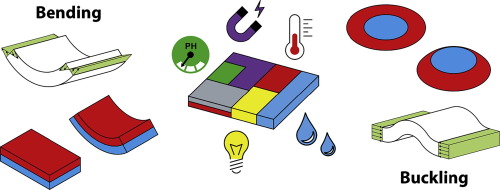当前位置:
X-MOL 学术
›
Mater. Today
›
论文详情
Our official English website, www.x-mol.net, welcomes your feedback! (Note: you will need to create a separate account there.)
Programming the shape-shifting of flat soft matter
Materials Today ( IF 24.2 ) Pub Date : 2018-03-01 , DOI: 10.1016/j.mattod.2017.08.026 Teunis van Manen , Shahram Janbaz , Amir A. Zadpoor
Materials Today ( IF 24.2 ) Pub Date : 2018-03-01 , DOI: 10.1016/j.mattod.2017.08.026 Teunis van Manen , Shahram Janbaz , Amir A. Zadpoor

|
Shape-shifting of flat materials into the desired 3D configuration is an alternative design route for fabrication of complex 3D shapes, which provides many benefits such as access to the flat material surface and the ability to produce well-described motions. The advanced production techniques that primarily work in 2D could then be used to add complex surface features to the flat material. The combination of complex 3D shapes and surface-related functionalities has a wide range of applications in biotechnology, actuators/sensors, and engineering of complex metamaterials. Here, we categorize the different programming strategies that could be used for planning the shape-shifting of soft matter based on the type of stresses generated inside the flat material and present an overview of the ways those mechanisms could be used to achieve the desired 3D shapes. Stress gradients through the thickness of the material, which generate out-of-plane bending moments, and compressive in-plane stresses that result in out-of-plane buckling constitute the major mechanisms through which shape-shifting of the flat matter could be programmed. We review both programming strategies with a focus on the underlying physical principles, which are highly scalable and could be applied to other structures and materials. The techniques used for programming the time sequence of shape-shifting are discussed as well. Such types of so-called “sequential” shape-shifting enable achieving more complex 3D shapes, as the kinematics of the movements could be planned in time to avoid collisions. Ultimately, we discuss what 3D shapes could be achieved through shape-shifting from flat soft matter and identify multiple areas of application.
中文翻译:

平面软物质的变形编程
将平面材料的形状转换为所需的 3D 配置是制造复杂 3D 形状的另一种设计途径,它提供了许多好处,例如访问平面材料表面和产生良好描述的运动的能力。然后可以使用主要用于 2D 的先进生产技术为平面材料添加复杂的表面特征。复杂 3D 形状和表面相关功能的组合在生物技术、执行器/传感器和复杂超材料工程中具有广泛的应用。这里,我们根据扁平材料内部产生的应力类型对可用于规划软物质变形的不同编程策略进行了分类,并概述了这些机制可用于实现所需 3D 形状的方式。通过材料厚度的应力梯度,产生平面外弯矩,以及平面内压缩应力,导致平面外屈曲,构成了主要机制,通过这些机制可以对扁平物质的形状转变进行编程. 我们回顾了两种编程策略,重点关注基本物理原理,这些原理具有高度的可扩展性,可以应用于其他结构和材料。还讨论了用于对变形时间序列进行编程的技术。这种所谓的“顺序”形状转换能够实现更复杂的 3D 形状,因为可以及时规划运动的运动学以避免碰撞。最后,我们将讨论通过从扁平软物质进行形状转换可以实现哪些 3D 形状,并确定多个应用领域。
更新日期:2018-03-01
中文翻译:

平面软物质的变形编程
将平面材料的形状转换为所需的 3D 配置是制造复杂 3D 形状的另一种设计途径,它提供了许多好处,例如访问平面材料表面和产生良好描述的运动的能力。然后可以使用主要用于 2D 的先进生产技术为平面材料添加复杂的表面特征。复杂 3D 形状和表面相关功能的组合在生物技术、执行器/传感器和复杂超材料工程中具有广泛的应用。这里,我们根据扁平材料内部产生的应力类型对可用于规划软物质变形的不同编程策略进行了分类,并概述了这些机制可用于实现所需 3D 形状的方式。通过材料厚度的应力梯度,产生平面外弯矩,以及平面内压缩应力,导致平面外屈曲,构成了主要机制,通过这些机制可以对扁平物质的形状转变进行编程. 我们回顾了两种编程策略,重点关注基本物理原理,这些原理具有高度的可扩展性,可以应用于其他结构和材料。还讨论了用于对变形时间序列进行编程的技术。这种所谓的“顺序”形状转换能够实现更复杂的 3D 形状,因为可以及时规划运动的运动学以避免碰撞。最后,我们将讨论通过从扁平软物质进行形状转换可以实现哪些 3D 形状,并确定多个应用领域。


























 京公网安备 11010802027423号
京公网安备 11010802027423号